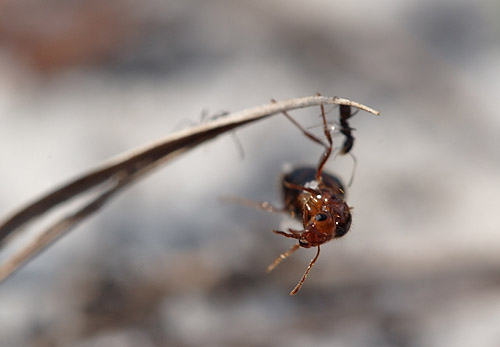Life is perilous for young ant queens. This fire ant (Solenopsis invicta) is being pursued by native Forelius ants after her mating flight in central Florida. She frantically climbs a grass blade to escape, but to no avail- the attackers follow. She will make an excellent source of protein to feed the Forelius larvae.
Two larger points about this photo. First, establishing new colonies is tremendously difficult. The founding stage is when most colony-level mortality happens, and this excessive mortality is why ant nests produce hundreds of queens every year in the hopes that a handful survive.
Second, native ants may be our best friends in combating the spread of introduced pest ants. Healthy, intact native habitats with thriving local ant populations make it more difficult for intruders like the fire ant to gain a toe-hold. The more we alter habitat and the more we use generalized pesticides, the more problems we cause our native species and the easier it is for pests to establish.
Photo details: Canon 100mm f2.8 macro lens on a Canon EOS 20D
ISO 400, f/8, 1/500 sec, ambient light


Wisdom spreadeth from the glorious pages of Alex's webdom.
"Healthy, intact native habitats with thriving local ant populations make it more difficult for intruders like the fire ant to gain a toe-hold. "
Bravo, Alex!
I have seen evidence of this phenomenon not only for fire ants in the Southeast (and even in their native South America, where they are largely associated with manmade or riparian disturbance); but also for Argentine ants in California, which barely penetrate unirrigated native habitats; and for Japanese pavement ants here in the St. Louis area, which prefer gravel lots, sidewalks, lawns, gardens and cultivated areas over any decent-sized area of native vegetation.
On the other hand, in some places is difficult, but not impossible. It seems that intact native vegetation on islands and and island-like places such as southern Florida are less resistant to invasion by new species. In the Florida case, fire ants and Argentine ants still dominate the human-disturbed sites, but many other species of non-native ants have colonized the Everglades, scrub and oak woodlands.
Oh, by the way, if you happen to be at ESA in Indy in Dec. I will be talking about just this subject and some data from some new experiments on queen founding in a variety of habitats that Walter and I dreamed up. Weird, huh?
I was wondering if anyone had ever done a study on the effect of filling an area infested with nonnative invasive ants with native plants.
I don't really have an invasive species problem in my yard besides the pavement ant, but I've noticed simply including more dead wood structures I'm seeing an increase in wood nesting ants. More Lasius alienus colonies as well two species of Camponotus that hadn't been in my yard before. It's not much but surely more hollow stemmed plants and nut producing trees would encourage more opportunistic species, and so on.
Awesome. I look forward to hearing about it. I'll be at ESA too, presenting some genetic evidence for a Paraná origin of the introduced Pheidole obscurithorax.
Oooo! P. obscurithorax is one of my all time favorites - I'll be sure to drop in on your talk.
DId you save her, Alex?
Nice post - good point about the perilous nature of colony founding. I documented something like this earlier this year and managed to get a few good photos of the action.
So very true about introduced ants being buffered by the expansion of native ants as well. Our wetlands suffer heavily at the claws of the Argentine ant, but weeding and revegetation programs are slowly seeing the return of common but native species (in my neck of the woods anyway).